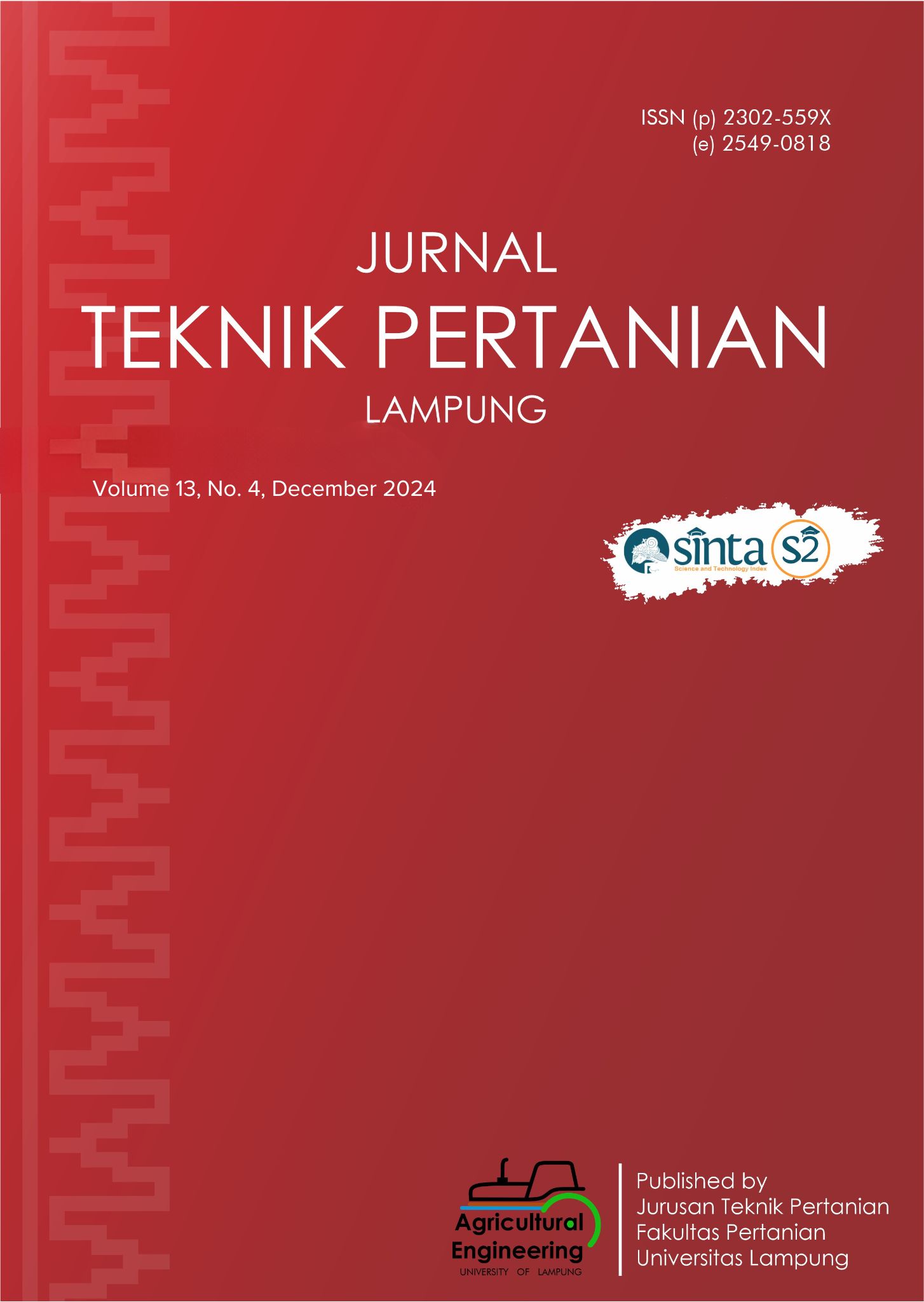Drying Characteristics of Papaya (Carica Papaya L.) Fruit Leather Using Microwave Oven
DOI:
https://doi.org/10.23960/jtep-l.v13i4.1403-1409Abstract
Fruit leather is a thin sheet of oven-dried fruit flesh. While papaya fruit is a perishable fruit with various types of fruit leather is one of the processed food products that can be preserved and has added value. This study aimed to determine papaya fruit leathers drying characteristics using a microwave oven, namely changes in water content, drying rate, color, and water activity. The methods used were experimental methods with treatment variables of different microwave power (329 W, 428 W, and 701 W) and material thickness (1 mm, 3 mm, and 5 mm). The research design was selected in complete randomization with 3 replications. The results showed that the moisture content value decreased from 87.10-87.67%bb to 10.21-16.51%bb. The highest drying rate occurred at 701 W power and 1 mm material thickness with a value of 282.79%bb. The highest total color (E) value occurred in the treatment of 701 W power and 1 mm material thickness which was 28.78. The highest water activity (aw) value occurred at 329 W power treatment and 5 mm material thickness which was 0.463.
Keywords: Drying, Fruit leather, Microwave, Papaya.
References
AOAC. (2005). Official Methods of Analysis (18th ed.). AOAC International.
Astuti, T., Widowati, E., & Atmaka, W. (2015). Kajian karakteristik sensoris, fisik, dan kimia fruit leather Isang Tanduk (Musa corniculata Lour.) dengan penambahan berbagai konsentrasi gum arab. Jurnal Teknologi Hasil Pertanian, 8(1). https://doi.org/10.20961/jthp.v0i0.12786
Bahanawan, A., & Sugiyanto, K. (2020). Pengaruh pengeringan terhadap perubahan warna, penyusutan tebal, dan pengurangan berat empat jenis bambu. Jurnal Penelitian Hasil Hutan, 38(2), 69–80.
Brooker, D.B., Bakker-Arkema, F.W., & Hall, C.W. (1992) Drying and storage of grains and oilseeds. The AVI Publishing Company, Westport.
Chowdhury, K., Khan, S., Karim, R., Obaid, M., & Hasan, G. (2012). Quality and shelf-life evaluation of packaged biscuits marketed in Bangladesh. Bangladesh Journal of Scientific and Industrial Research, 47(1), 29–42. https://doi.org/10.3329/bjsir.v47i1.10717
Effendy, S., Aswan, A., Ridwan, K.A., Zurohaina, N.R., & Amanda, T.J. (2020). Pengaruh daya microwave dalam proses pengolahan minyak mawar (Rosa hybrida) dan minyak ylang-ylang (Cananga odorata genuine) dengan metode microwave hydrodistillation. Jurnal Kinetika, 11(3), 20–27.
Fauziah, E., Widowati, E., & Atmaka, W. (2015). Kajian karakteristik sensoris dan fisikokimia fruit leather pisang tanduk (Musa corniculata) dengan penambahan berbagai konsentrasi karagen. Jurnal Aplikasi Teknologi Pangan, 4(1).
Hartulistiyoso, E., & Sudarmaji, K. (2005). Pengeringan lada putih (Piper nigrum L.) menggunakan gelombang mikro (microwave). Prosiding Seminar Nasional Teknologi Inovatif Pascapanen untuk Pengembangan Industri Berbasis Pertanian. IPB (Bogor Agricultural University).
Herlina, H., Belgis, M., & Wirantika, L. (2020). Karakteristik fisikokimia dan organoleptik fruit leather kenitu (Chrysophyllum cainito L.) dengan penambahan CMC dan karagenan. Jurnal Agroteknologi, 14(2), 103–114. https://doi.org/10.19184/j-agt.v14i02.12938
Hirun, S., Utama-ang, N., & Roach, P.D. (2014). Turmeric (Curcuma longa L.) drying: An optimization approach using microwave-vacuum drying. Journal of Food Science and Technology, 51(10), 2127–2133. https://doi.org/10.1007/s13197-012-0709-9
Lestari, N.P., Purbasari, D., Sholihuddin, M., & Taruna, I. (2023). Drying characteristics of jelly ear mushroom (Auricularia auricula) using microwave oven. Jurnal Teknik Pertanian Lampung, 12(1), 28–38. https://doi.org/10.23960/jtep-l.v12i1.28-38
Leviana, W., & Paramita, V. (2017). Pengaruh suhu terhadap kadar air dan aktivitas air dalam bahan pada kunyit (Curcuma longa) dengan alat pengering electrical oven. METANA, 13(2), 37-44.
Mukmin, M., Muhidong, J., & Azis, A. (2021). Evaluation of page model performance on thin layer drying of iles-iles roots. Jurnal Agritechno, 14(1), 18–25. https://doi.org/10.20956/at.v14i1.399
Nurhawa, N., Muhidong, J., & Mursalim, M. (2018). Perubahan dimensi temu putih (Curcuma zedoaria Berg. Roscoe) selama pengeringan. Jurnal Agritechno, 9(1), 44–54.
Nurmuliana, E., Jamaluddin, J., & Mustarin, A. (2022). Model matematika lapisan tipis pengeringan buah mahkota dewa (Phaleria macrocarpa). Jurnal Pendidikan Teknologi Pertanian, 8(1). https://doi.org/10.26858/jptp.v8i1.21675
Praseptiangga, D., Aviany, T.P., & Parnanto, N.H.R. (2016). Pengaruh penambahan gum arab terhadap karakteristik fisikokimia dan sensoris fruit leather nangka (Artocarpus heterophyllus). Jurnal Teknologi Hasil Pertanian, 9(1). https://doi.org/10.20961/jthp.v9i2.12858
Rahmawati, R., & Fachriah, K. (2021). Physicochemical and sensory characteristic of starfruit-red guava fruit leather as affected by the addition of arabic gum. Jurnal Teknologi (Sciences & Engineering), 84(1), 11–19. https://doi.org/10.11113/jurnalteknologi.v84.16642
Sinaga, A.S.R.M. (2019). Color-based segmentation of batik using the L*a*b color space. Sinkron : Jurnal dan Penelitian Teknik Informatika, 3(2), 175-179. https://doi.org/10.33395/sinkron.v3i2.10102
Taris, M.L., Widodo, W.D., & Suketi, K. (2015). Kriteria kematangan pascapanen buah pepaya (Carica papaya L.) Callina dari beberapa umur panen. In E. Widaryanto, N. Aini, N. Barunawati, & A. Setiawan (Eds.), Peningkatan daya saing produk hortikultura nusantara dalam menghadapi era pasar global: Prosiding seminar ilmiah Perhimpunan Hortikultura Indonesia (PERHORTI). Bandung.
Wray, D., & Ramaswamy, H.S. (2015). Novel concepts in microwave drying of foods. Drying Technology, 33(7), 769–783. https://doi.org/10.1080/07373937.2014.985793
Downloads
Published
Issue
Section
License
- Authors who publish with this journal agree to the following terms:
- Authors retain copyright and grant the journal right of first publication with the work simultaneously licensed under a Creative Commons Attribution-ShareAlike 4.0 International Lice that allows others to share the work with an acknowledgement of the work's authorship and initial publication in this journal.
- Authors are able to enter into separate, additional contractual arrangements for the non-exclusive distribution of the journal's published version of the work (e.g., post it to an institutional repository or publish it in a book), with an acknowledgement of its initial publication in this journal.
- Authors are permitted and encouraged to post their work online (e.g., in institutional repositories or on their website) prior to and during the submission process, as it can lead to productive exchanges, as well as earlier and greater citation of published work (See The Effect of Open Access).
Jurnal Teknik Pertanian Lampung

JTEPL is licensed under a Creative Commons Attribution-ShareAlike 4.0 International License.

